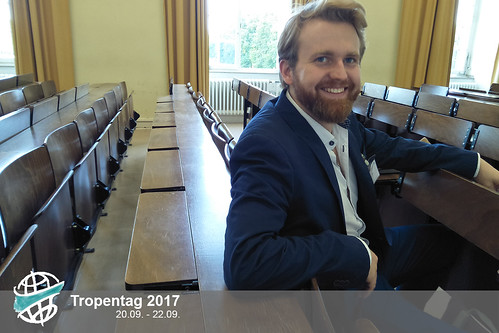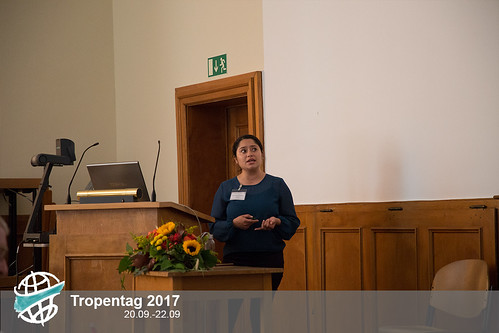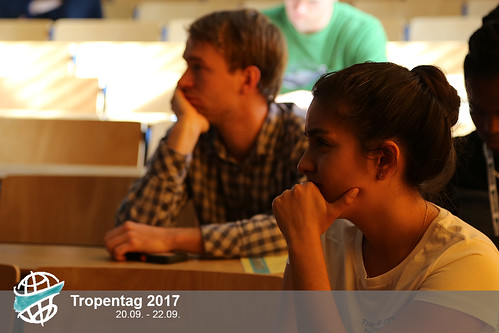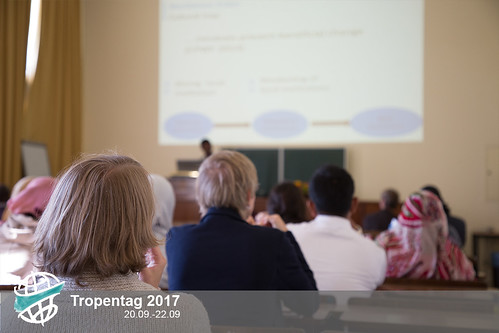Blogs
ICRAF on Improving Agroforestry Farming Systems
Fri, 09/22/2017 - 10:01 — mustamin.fadliHow to Engage Young People in Agriculture?
Fri, 09/22/2017 - 09:46 — mustamin.fadli
Agroforestry Won't Save the World, but our Planet
Thu, 09/21/2017 - 19:06 — marlemkeAccording to the numerous audience's questions, agroforestry is in demand.
Of course! In terms of water and nutrient efficiency, trees are optimum, and hence are key for solving problems like nitrogen leaching and drought mitigation. Moreover, they can provide an additional income source for (smallholder) farmers in terms of fruit, medicine and timber. Their ecological value cannot only be reduced to shade provision and hydraulic lift for water and plant nutrients, they also function as a shelter belt for annual crops nearby. Trees also drastically reduce wind speed, minimizing transpiration. Niels Thevs from ICRAF reinforced these points in his oral presentation.
As far as resource efficiency is concerned, trees can substantially contribute to mitigate climate change and secure the existence of smallholders.

Ending Hunger... or Writing Papers?
Thu, 09/21/2017 - 18:09 — megreslerLike many of my peers in attendance at for the "BMEL Session," oral presentations, I have spent the last year wrestling with one quite specialized, and quite complex, research problem. Mine falls under the umbrella question, "What are pathways towards sustainable food system transformation?". Safely contained within this one research question, I am often tempted to isolate the subtleties of my research from the sweeping and disastrous reality, hunger. Occasionally lost within an abstract cloud of data and theory, I try to remind myself of the necessity of resituating my research within the context of the larger research environment.
The logical, but not always obvious, next question: Should we extend this interrogation one step further and question how our research, our knowledge, and our resources, will be used in application to better society? Are we making change, or are we just writing papers?
Dinner is Served...the Desert Locust!
Thu, 09/21/2017 - 18:06 — lizkusiaPhillip Straub, a first-time participant at Tropentag has developed a diet for the desert locust. The outstanding young German researcher submitted an abstract from his Bachelor’s degree thesis. He was overwhelmed after hearing he was selected for an oral presentation. To say the least, he was very excited. Philip is convinced that insects for food is the next big thing. “There are new developments every day, it is exciting,” he said. Philip won a GIZ scholarship to carry out his research project at the International Centre of Insect Physiology and Ecology (ICIPE), Kenya.

He sought to develop a storable diet for the desert locust that could be used for mass rearing. The desert locust is consumed by humans and can also be used as an animal feed supplement. He tested five different formulations for human food. They mainly consisted of powdered cowpea, cornmeal, soy bean and carrots in different ratios. Some were enriched with multivitamins. Two diets worked well. “My findings are a starting point for optimizing diets with a longer shelf-life for insects,” he explains.
The Ice is Melting! Perceptions of Climate Change in Peru
Thu, 09/21/2017 - 18:01 — giulia.rotanodari71% of tropical glaciers in South America are found in Peru and the ongoing increase in the average global temperature is causing their retreat in many areas, threatening livelihoods.
Yaremi Karina Cruz Rivera, from Cologne University of Applied Sciences, analyzed the perceptions of climate change of four communities living in the surrounding area of the Chicon glacier, one of the highest tropical glaciers in Peru, and the source of water for the Chicon Watershed. The four communities make use of the water in this area for human consumption and agriculture.

The aim of the investigation was to assess the awareness of the communities, in particular of women, of the hazards linked to climate change. Results showed that people perceive that temperatures are increased and extreme climactic events such as droughts, floods and frosts have occurred frequently in the last decade, but drought is the most imminent challenge.
The four communities demonstrated an awareness of the threat of climactic change to agriculture and their livelihoods, leading to an interest in implementing activities and ecological approaches, such as afforestation in the watershed together with the local government.
Is there an I in 'Science?'
Thu, 09/21/2017 - 18:00 — megreslerBy sharing her narrative as a young girl who questioned why some crop fields were peppered with trees while others were not, Lin Bautze from the Research Institute of Organic Agriculture in Germany unintentionally posed an important question to the audience of Oral Presentation III "Production Methods" on Thursday afternoon. Should research stand by itself, without acknowledging the role of the researcher? Or does the lived experience of a researcher, like Bautze, and the ways it shaped the trajectory of her research, create a new space for the audience to explore the research?
This is certainly a controversial discussion between qualitative researchers, whose position on the research paradigm may vary. Quasi-foundationalists, like myself, would acknowledge a unique lens through which individual researchers analyze and interpret their data. Assuming their analysis is conducted with purposeful reflexivity and self-awareness, I believe that research in #FutureAgriculture has something foundational to gain from the person/s involved in gathering, sorting, analyzing and interpreting their data. From this perspective, I argue we are better equipped as researchers when we allow our intersectionalites to contribute to robust analyses of our data.
This is what Bautze has done in her exploration of alley cropping as an adaptation strategy for a future changing climate in Africa. This should also be the direction #FutureAgriculture research continues moving forward in.

Attention: Bring your research closer to farmers!
Thu, 09/21/2017 - 17:01 — Hana KhanhIn order to increase the productivity of potatoes in Rwanda, researchers created new certified seeds (formal system) to replace the commonly used, low quality and low yielding seeds (informal system). However, unfortunately, Leone Ferrari and her team found that certified seeds are still underutilized.
While conducting her research on four of the most productive districts in Rwanda for potatoes, Leone Ferrari realized that farmers using certified seeds represented only around 5% of the national required demand. Producing certified seeds in Rwanda is necessary, but is still not enough.
She insisted that the formal and informal systems of potato seeds in Rwanda must be complementary and mutually dependent. She recommended developing strong linkages with farmers to distribute certified seeds.
In the end, it comes back to the fundamentals, a close relationship with and awareness of farmers. Hopefully, her research add urgency to the need for experts, researchers, policy makers to put more effort in bringing their research and work closer to the farmers.






